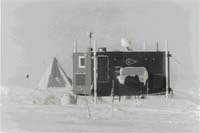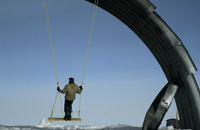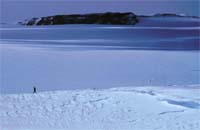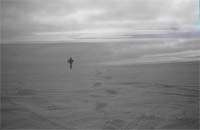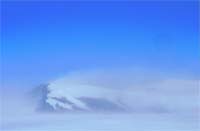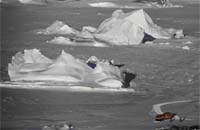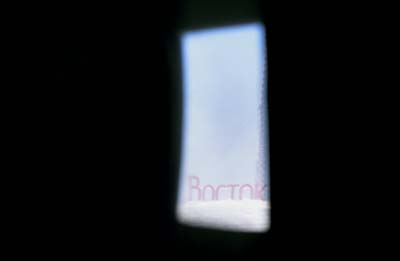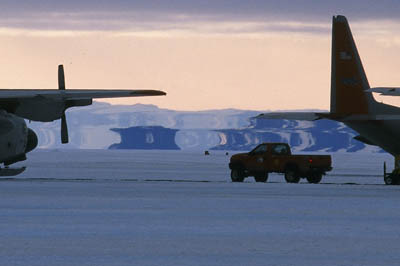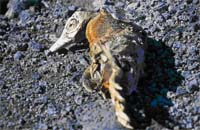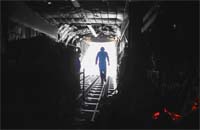AGO 1
Published in the anthology Antarctica: Life on the Ice, Travelers Tales (Fall 2007)

November, 2000: After five seasons of fairly civilized Antarctic work, I took on a ominous job offered to me at the end of the polar summer by a drunken friend. Kip reeled across the floor of McMurdo Station's darkened carpenter shop during its massive end-of-season party in February and shouted a slurred version of the question we all ask at the end of an Antarctic contract: "Hey man, are you coming back next year?"
When I shrugged the shrug of the restless, he yelled "You should come back and work for AGO next year. It's crazy!" AGO (pronounced like the end of "Winnebago") is the Automated Geophysical Observatory program, the maintenance of which demands some of the most notorious work in the United States Antarctic Program (USAP). Kip had graduated to management, and would be doing the hiring.
Eight months later, I was back in McMurdo preparing to journey outward with a few others to a string of isolated motes across the top of the godforsaken East Antarctic ice cap. Bella, the lead groomer, and I would be joining engineers Joe and Jack on journeys to AGO 1, AGO 4, and AGO 5. Another team would be flying out to 2, 3, and 6. East Antarctica is the coldest and most inaccessible geography on Earth, a plateau of ice ranging from one to three miles deep, larger than the United States and, except for a handful of people in government-issued parkas, empty of land and life.
AGO sites are visited only once a year to update experiments and to bring in three thousand gallons of propane to power the automated project through the upcoming winter. The engineers download the previous year's data and reset, rebuild, or replace the electronics in each AGO unit. Each site has a collection of experiments measuring electromagnetic radiation (EMR) from the sun. These experiments are particularly concerned with the massive bursts of energy that storm over the Earth after the eruption of solar flares.
Our four-person team would be flying out to AGO 1 by Twin Otter, a small sturdy bush plane used in all the wild corners of the planet. Then Bella would show me how to smooth out at each AGO site a 10,000 foot landing strip for the huge propane-laden LC-130 Hercules aircraft. The Hercs land on massive skis (thus we make a skiway, not a runway) which damage easily on rough landings. The last thing the Guard wants is to work on a plane out at an AGO site. Intensive, complex work is nearly impossible in the severe cold of the high plateau.
Nervous about doing what was rumored to be brutal work, I had heard that at AGO sites altitude sickness and frostbite are not uncommon, snowmobiles are repaired endlessly at 30 below, and teams may be stuck for weeks because of weather. AGO 1 was my first pure fieldwork job, after a few seasons taking shorter or milder journeys throughout the USAP as I worked fueling aircraft. I'd worked in tiny permanent outposts just a short helicopter ride from McMurdo, and spent several weeks in quasi-permanent tent cities during the mellow West Antarctic summer. Most work in the USAP takes place on McMurdo's stony shoreline, where secretaries and plumbers stroll between dormitories, workcenters, and the cafeteria. But AGO sites hearken back to the old days, when a few souls were flung by groaning plane to camp in the flat white heart of cold.
Joe, the lead engineer and general AGO mastermind, had already done nearly 30 of these trips over the previous several years. He talked to us with his soft-spoken Alabama voice about how we want things to go, and how badly they might go. "We really need to look after each other out there, guys. Temperatures should be around 30 below. Check each other's faces for white patches, and take it easy snowmobiling and shoveling. Warm up when you need to. Keep track of each other. We'll be a long way from home, and if you're hurt it might take a few days to get you to McMurdo's clinic, much less to a real hospital in New Zealand. Things should go fine, but remember that things can get really difficult really quickly out there." I'll know in a few weeks whether or not to thank Kip, who no longer works in the field.
Thank God for Bella, I kept saying to myself, as she led me through the 10,000 details of planning food, overhauling gear, and preparing ourselves for all contingencies. She taught me how to rebuild engines for the 30 year-old snowmobiles used to groom the skiways. She tested radios while I gathered oatmeal and pesto; she packed up spare snowmobile parts while I searched for bamboo poles. We put together our medical kit and purchased our liquor. We scratched items off lists; she and I both made new lists.
I learned in those days how to assemble a field camp from McMurdo's logistical maze. I knew town intimately from five summers of work, and Bella knew what life in the field required: between us, with Joe's input, we built a raft of cargo and food for our journey out onto the sea of ice that fills interior Antarctica Bella fled Cape Cod years ago for Alaska, and has worked many contracts drilling ice cores in Greenland and the Antarctic. I could always spot her among McMurdo's swarm of red parkas because of her large fur hat, spun from the hair of her best sled dog.
The heart of American Antarctica is McMurdo Station, a nearly graceless town of over a hundred prefab structures, busy with forklifts and trucks moving cargo to and from planes flying to New Zealand, South Pole station, and the field camps. McMurdo squats on the volcanic rock of Ross Island, but offers a heartbreakingly beautiful view of the Transantarctic Mountains across 40 miles of frozen ocean. The view is heartbreaking in part because few of the 1200 people who keep McMurdo humming are given a chance to see it up close. Four fifths of the residents are contract workers who keep town and transportation running, supporting the famous science done by the other fifth. Most residents never leave McMurdo.
Bella and I were leaving in a few days, crossing the tantalizing flood of ice from the East Antarctic ice cap that flows over the shoulders of the mountain barrier and down to the sea in great glaciers. AGO 1 waited a few hundred miles inland, a dark speck in the white universe of the ice cap.
"He was lost! Lost in blizzard land! Lost in vast spaces that spread about him for thousands of miles! Lost without food or fuel! Lost with a crazy man, whom he and his companions had to wheedle, cajole and threaten to keep him moving at all! Lost without a compass in the Antarctic!"
—F. W. Dixon, Lost At The South Pole
Nov. 8: On suspicion of emerging schizophrenia, Jack, the electrical engineer that was to fly with Bella, Joe and me to AGO 1 was told that he would not be allowed to do fieldwork. A bright Ph.D. student, this was Jack's first trip to the Antarctic. Now it looks like it's also his last.
Small idiosyncrasies like changing his name en route to the continent (a sudden interest in President Kennedy had prompted John to ask to be called Jack), or obsessive staring at McMurdo's women (he was asked to leave from at least one workcenter), came first; then public statements on telepathy within dreams and aliens in Antarctica gave us pause. McMurdo's rumor mill was buzzing about our odd expedition partner. None of his quirks were dangerous vices, but because Jack's distance from predictability grew rapidly as the date for deploying to East Antarctica neared, Joe asked Steve, the wary manager of field science support, to interview him. As a mountaineer, Steve had dealt with personality problems in remote settings before: when his round questions were met with square answers, he quickly banned Jack from heading out with us into the great white unknown. None of us were happy with the situation. Joe needed Jack's expertise and the extra pair of hands. The four of us were a small team heading off to a very difficult place, and the job would be much harder with one less. Worse, we couldn't be sure that he was a real problem. There were big gaps in his conversation, but I thought he was more absent-minded than delusional.
Indignant at the possible injustice, Bella kept saying: "We wouldn't think twice about this guy's ideas back home. I know people in Alaska who think they've been talking with aliens for years."
She and I had been annoyed that Jack would sometimes drift off from our preparations, only to be found later apparently attempting telepathy while gazing far too intently at an annoyed woman, but mostly he did his work and did it well. For his part, Jack was very upset, about both his image in the McMurdo community and the future of his Ph.D. work. But his protest was quiet and short-lived: the look in his eye told me this wasn't the first time he'd had trouble. One definition of insanity defines it as the inability to choose among false alternatives. The consequences of an acutely delusional companion in Antarctic isolation could be severe. What better landscape to place the object of an invisible fantasy than the tabula rasa of the ice cap? How would we manage him if he fought to prove his convictions? What if he took a snowmobile and headed out to nowhere at full speed?
So his wings were clipped not so much for the foolishness of his ideas or our confidence that he was unfit, but for the consequences, the what-ifs. Our risk was based on whether our companion would be able to discern the difference between reality and imagination, in a landscape that's quick to punish both. His compass went awry a short time later. He announced publicly, going table to table in the galley, that the mothership would be arriving at noon next Thursday to pick him up. Come Thursday, our engineer had to settle for delivery by a cadre of upper management, who hustled him off to a quiet room, then booked him on the first flight north.
Thursday was a sad day for everyone but a bunch of chuckling spectators, none of whom seemed to notice as I had the strange bank of fog that raced into town precisely at noon.
Nov. 13: Arrived at AGO 1. The Twin Otter gave Bella and me a slow four-hour introduction to the strange heart of cold. (Joe came alone with the rest of the gear on the second flight several hours later.) Leaving McMurdo, our plane immediately ramped up from sea-level to aim through the mountains, up through local turbulence, the small plane jolting and dropping, kicking forward.
The Twin Otter was unpressurized, unheated, and packed to the roof with two thousand pounds of cargo. As the increasing cold, the language of our destination, whispered to us, Bella and I began the familiar Antarctic descent into the catacombs of the self. Hood up, chin down, feet up on the cargo, we spent our time in a zone somewhere between mild hypothermia and simple flight-driven sleep. We kept very quiet within the deep drone of the Otter. We stared at the jumble of gear and food boxes haphazardly strapped down, crammed in within inches of us. In a crash, all of it would drive through us like water from a broken dam. Otherwise we alternately dozed off and thought about the lonely landing ahead. The cold had expectations of us.
Waking mid-flight, everything motionless but for the blurred props, I looked out to see we were still floating above the scattered ice-drowned peaks at the inside edge of the Transantarctic Mountains. Still a long way to go. We were drifting up to 10,000 feet, making our invisible path to a little white spot in the midst of an absurdly powerful emptiness.
Nov. 14: Bella, Joe and I tucked ourselves into our new home, an orange 8x16 foot insulated box on posts. Outside, a full-on ground blizzard raged, with 30 knot winds at -34° F limiting us to 100 foot visibility. Yesterday, after each flight, the Otter pilots stuck around only long enough to unload and refuel; in 20 minutes they were back in the air, a few empty hours away from home. The wind rose after our plane landed, with Bella's hood shaking around her head as she radioed McMurdo.
"MacOps, MacOps, this is AGO 1, AGO 1, on 10.995, over. How copy, over?" For a moment, she and I stood there surrounded by our boxes, bags, and bamboo on the edge of a runway overrun with last year's sastrugi (hardened waves of snow). Beyond the runway and our AGO box there lay a flat white lifeless ice plateau the size of America. Beneath us two miles of ice pressed the continent into the Earth's mantle. The ground blizzard hit us an hour after Joe's plane left.
After landing, Bella and I threw the essential gear and do-not-freeze items into the AGO box, and then quickly began the struggle to set up our toilet tent. With the wind already at 20 knots, the Scott tent fought us like a wounded umbrella. We finally managed to get the feet planted and its anchors tied off; I moved inside to dig the outhouse hole while Bella tried to set up her own personal tent. Despite the hassles of camping at 35 below, she wanted her own cold space. Even after I shuffled over to help her, however, with the wind now at 25 knots, she decided to give up until a better day.
A "ground blizzard" brings no precipitation; rather, the wind rises to a force strong enough to lift loose snow up into a raging white wall. The snow sometimes flies in a stream only several feet high, so that we can climb above it into a clear blue sky. When a thin veneer of loose snow covers an upwind area larger than Europe, however, life gets serious: a day-long ground blizzard will bury everything we own in a crystal-built cement.
The AGO box was shipped in by Herc several years ago. A modified shipping container that looks like a hybrid of a small RV and an engineering lab, it contains a pile of electronics, a TEG (a thermoelectric generator, which generates power from the burning of propane), some cupboards and shelves, and four fold-down bunks. Nevertheless, the luxury of stepping off a plane into a weatherproof cube in East Antarctica changes everything. We were safe and comfy on the far side of the moon.
We spent the day listening to Marvin Gaye (Bella) and reading Rilke (me) or science fiction (Joe). Visibility outside was less than a hundred feet. The toilet tent was a pale yellow blur. Even though the wind sweeps around and under the box, we kept warm with a portable propane heater. (The TEG was busted.) Looking out one of our two tiny end-windows at the white froth, I felt like one of three sailors lost in some deep ocean fog. As I looked out from our little vessel, I could believe that we were in a small craft sailing upwind, toward the source of the blowing snow, toward whatever it is that unravels our little flags.
We were supposed to be in and out of AGO 1 in six days, but already the clock's ticking had slowed to a hypothermic pace. With the storm here and Jack absent, our trip was bound to be extended.
I'd like to think that if Jack had made it out to AGO with us, the hard beauty and strange reality of what surrounded us would have helped focus him on the work at hand. But perhaps the stress of the otherworldly emptiness might have sent him over the edge.
What I found in myself again was my pleasure in hard weather and extremity. A stormed-in day at AGO 1 is much more pleasant than the anxious packing for AGO 1. A journey begun is always better than a journey in preparation, and now I'd arrived, snuggled into the corner of the future I'd worried about for the last eight months. Joe, who has done more of these trips than anyone, said that the wind at this site has two characteristics: "It always blows, and it always blows from the same direction. Usually it blows lightly, but not this time, I guess."
Before the white blindness arrived, our world was a white featureless icescape contained within a simple circle of horizon. Through it we seemed to sail against the familiar, against the idea of destination, and we could not alter our path except in imagination. We could pretend to tack by stepping across to the other window… Or we could bundle up to launch our own lifeboats, our bodies, into the wind and cold, and hope sometime later to find our elevated home right where we left it.
"The outlook was by no means encouraging, as the surface still bristled with huge ice undulations as far as the eye could reach. It was just as though a stormy sea had suddenly been frozen solid…"
—Edgeworth David, 1908, in The Heart Of The Antarctic
"…the plateau over which we are now travelling resembles a frozen sea…"
—Roald Amundsen, 1911, quoted in Scott And Amundsen
"The snow was getting more and more uneven the further south I went. The ridges crossed at right angles to my course and looked like a heavy sea that had suddenly frozen solid."
—Borge Ousland, 1996, Alone Across Antarctica
The surface of Antarctica is in motion, relentlessly sculpted by the wind into sastrugi. The universal experience of sastrugi (a Russian word) is of an ocean frozen in motion: it's the inescapable metaphor brought down from the liquid north. Travelers' imaginations have been strung together as a continuum of land-or-sea aesthetics. Present-day descriptions of the plateau, by adventurers, journalists, or USAP workers, still use this stock image.
Any other metaphor would violate scale by comparing the texture of sastrugi to, say, sand dunes or the undulations of fresh whipped cream. Sand dunes grow far too large (sastrugi are usually just knee-high, though may reach six feet), and feel far too soft underfoot (sastrugi can be as hard as ice in this deep cold).
The form of a moving wave is beautifully recreated in the slow-sculpted surface of snow. On the water, both wind and wave are fluid; on the ice, only the wind flows, while the snow is pushed along like dust, adhering, degrading.
Whether landing a Herc on a glacier, adventuring by ski to the South Pole, or grooming a skiway out of the squall-carved surface, we still find the frozen sea waiting as it has for eons. And as soon as our species turns away from the ice, the snow will crest and fall across our small history like waves over spindrift.
"What are they doing in Heaven today,
where sin and sorrow are all done away?
Peace abounds like the river, they say,
But what are they doing right now?"
—Washington Phillips, "What Are They Doing In Heaven Today"
Nov. 17: Waking with these 1920s gospel blues lyrics in my head after a fever-wracked "night" of restless sleep and difficult dreams, I found myself sweating in an orange box on stilts in the empty heart of Antarctica's bright twilight zone, which might, from a comfortably distant overflight, look like heaven. Life in the clouds and all that…
Washington Phillips was a little-known preacher from Texas who recorded a few songs and sermons with his high beautiful voice about the same time Admiral Byrd was down here on his first expedition, talking loosely of creating a perfect scientific community in this icescape. The two 20th century moral universes of church and utopia have informed American Antarctica right up to this point: we're still part of an exploration that glorifies science and pays lipservice to the language of faith. Every explorer cited the grace and handiwork of God, and we still maintain a shiny white chapel in the center of McMurdo. But the increasingly comfy USAP has replaced the talk of Providence with the pleasures of easy living in an exotic locale. The chapel sees more yoga classes than services. We support science that cares less about heaven than the turbulent mathematics of the heavens. What was I doing this day? Dragging my ass around, for one thing, but at least momentarily clean of obvious sin (isolated with Joe and Bella from worldly temptation, and too ill to drink wine with them) and too caught up with the wild strangeness of this life to consider sorrow. Grumpy from sleeplessness, I bundled up against what seems the temperature of outer space to shovel out boxes of food and a snowmobile buried for a long year in the dooryard of our little AGO haven. The wind came down some, and Bella set up her orange Scott tent and moved out while I slept late with my fever. We ran the snowmobiles a bit, moving gear around and pulling buried cargo out of their rock-hard drifts. It was far too cold to start the machines with their electric starters: even pull-starting them at 35 below is like tugging a horse that strains against its reins. But we needed to get comfortable with these 750 lb. beasts, because it would soon be time to ride them for long days of skiway grooming.
The body's only heaven here are the frames built to protect it. Our cubes and tents that keep us warm and wired to other people are our local version of the afterlife. After several hours of messing around in the cold, I ascended 10 feet above the frozen clouds and aspired to a songless night with peaceful dreams of earthbound sin.
"MacOps, MacOps, this is AGO 1 on 10.995, How copy?" "AGO 1, AGO 1, we have you weak but readable, How us, over?" "We have you loud and clear, MacOps. IS IT BETTER IF WE YELL, OVER?" "Loud and clear now, AGO 1. How are you doing, Over? "ALL IS WELL, MACOPS, ALL IS WELL. WE HAVE 3 SOULS ON BOARD AND ALL IS WELL. DO YOU HAVE ANY MESSAGES FOR US, OVER?"
Each morning, we call in (as required of all camps) to MacOps (McMurdo's communications center) to say we're alive, don't worry about us, and to see if there's any news for us from the other AGO team, AGO scientists at home, the flight planners, or friends. HF radio transmissions are an ephemeral thing, and even the loudest holler can sometimes sound like a feeble whisper in the blizzard of static. Sometimes we've had to call South Pole when McMurdo could not receive us, and ask them to relay our messages. Pole's antennas are not as powerful as McMurdo's, but we're closer to them and don't have to worry about the elevation drop from our ice cap through the mountains to the coast.
Even after several days here, the morning transition from warm breakfast and familiar voices on the radio to our parka-clad existence in the planet's Empty Quarter is still a shock. The waves of hard snow at our feet are more real and yet more strange than the frail invisible waves that throw our voices across the continent.
Nov. 20: Making a skiway is a beautiful and completely absurd task. To make a skiway 10,000 feet long and 150 feet wide out of a wilderness of hard sastrugi, we tow a homemade grooming machine that's only four feet wide. We might as well mow a path through an overgrown field with a pair of scissors. And just as grass grows back, so our little pragmatic Nazca line scratched into the field of topographic chaos will soon be wiped away by the next ground blizzard.
First the tooth and then the blade: the groomer, which consists of 800 pounds of improvised angle iron, does two things: four forearm-sized iron fangs shatter the surface into chunks, which the blade then crushes into fragments small enough to be evenly spread. It doesn't do them at the same time however: we harrow the 2 million square feet of the skiway, loading area, and turnarounds before removing the teeth and doing all 2 million square feet again with the blade.
The teeth and blade are set as deeply as the snowmobile can handle, usually just a few inches. (Someone like me went through the windshield a few years ago when the machine came to its usual dead stop after the teeth suddenly dug in too deeply.) Once they're bladed, the fragmented snow chunks sinter into a rough pavement. We took turns, working at full throttle for several hours at a time. Anything slower is useless. Hunched down behind the windshield, I end up both tense and bored, and always cold. We droned up and down two miles of sinuous white space, swaddled in thick layers of insulation, bucking and jumping over the rough sastrugi. Inside mittens the size of footballs, our right thumbs grew sore as hell from applying constant pressure to the throttle.
Sastrugi form in parallel with the prevailing wind, long waves of accreting snow porpoising out of the plateau. Skiways are also built into the prevailing wind, the groomer riding up and over abstract forms that threaten to tip us over. I was thrown off the snowmobile only a few times, though each time I raced up and over sastrugi narrower than the machine I made ready to jump. And this is one of the easiest, smoothest AGO sites. At AGO 6, the sastrugi reach over 3 feet, and persistent storms will carve up a new skiway a couple times before the Herc arrives with the propane.
With any luck the job can be done in two complete passes of both tooth and blade. This can take several days. Harder to remove, however, are the larger undulations in the skiway, swells beneath the waves, which could cause a Herc at high speed to slam a wingtip into the snow. These require intensive passes to bring them down, a few inches at a time.
Herc crews aren't allowed to shut down their plane's engines on the East Antarctic plateau, even at South Pole station. At a primitive AGO site, they want to land and leave as quickly as possible. No work gets done easily in the white emptiness, much less fixing a multimillion dollar plane. Parking it for repair at cold altitude means days of work and weeks of logistics. Other Herc flights would fly in people and equipment. Each extra flight here is an extra risk, and each flight takes away a flight scheduled for South Pole or elsewhere. One bad undulation on our skiway can easily affect the whole Antarctic program, including the lives of those who fly the planes.
Bella spent hour after hour working on these larger swells in the last two days, trying to make them friendly. I was up until 6 a.m. the "night" before, obsessed with blading the last portion of the skiway. Taking our safety rules to heart, Bella didn't sleep either, because she sweetly worried about me, popping out of her tent once in a while to see the little red and black dot that was me careening through the whiteness.
Grooming is a wild job in the furthest reaches of Antarctic climate and American logistics, and the absurdity of all this frenzied back-and-forth in the center of nothing does not escape me as I somewhat happily mow this insane lawn.
"I used to wonder sometimes whether the people who suffer from hunger in the big cities of civilisation felt as we were feeling, and I arrived at the conclusion that they did not, for no barrier of law and order would have been allowed to stand between us and any food that had been available. The man who starves in a city is weakened, hopeless, spiritless, and we were vigorous and keen."
—Ernest Shackleton, The Heart Of The Antarctic
No one starves in Antarctica anymore. Ross Island, once the desperate bit of rock that held the only full meals available to Shackleton, now sports Antarctica's big city. McMurdo is a law-and-order (or at least bureaucratic) town that tries clumsily to be civilization, and the living is so easy that tons of food per year are wasted.
Joe, a thin man who grew up on rich Southern cooking, told us one night after dinner: "The South is really bad for a person's figure." But he was talking about the Antarctic, not Alabama. Only new McMurdo employees are surprised that they can gain weight on the cafeteria's fat-rich diet. The same is true at the low-altitude West Antarctic field camps. We run the risk of filling out our ECW (Extreme Cold Weather) gear on the greasy food we crave after moving in and out of the cold all day.
Even in East Antarctica, gaining weight is not uncommon. While Russians at bitter Vostok Station (higher and colder than South Pole station) still grow thin eating from an impoverished potato-based menu, the well-fed Pole fattens up its managers and pencil-pushers. Outside, however, where calorie-sucking temperatures repelled the vigorous Shackleton, the cold still gnaws away at carpenters and mechanics.
The success of technology means, in part, that we can be on the far edge of nowhere but still be neither vigorous nor keen. Joe and Bella and I enjoyed this Antarctic irony, but not as much as we enjoyed the angel hair pasta with pesto and scallops.
"Yet there is more information in a single penguin than in all the polar plateau."
—Stephen Pyne, The Ice
The story of life, of biology intertwined with geography and fate, swims in the penguin's cells, while the East Antarctic plateau is a sketch of ice squatting on stone. Unlike the empty white chessboard of the Antarctic interior, each black and white penguin is a vortex of complexity, information spun up over time and space and through all the relationships of the flesh.
So why have penguins been chosen to represent Antarctica? Mainly because they do not represent Antarctica. Aside from us, there is no charismatic animal present in the great white space of the interior. An endless dead horizon, which is the aesthetic and physical essence of this continent, is not charming. Penguins fill the gap. They are the noble guardians at the gate: the world's gaze falters on the true white backdrop, and thus happily seizes on the cartoon on the coast. The power of this irrelevant but iconic advertising is apparently universal, since the geophysicists and engineers (rational beings, one assumes) who designed an AGO research project, have chosen a penguin as their symbol. Bella, Joe, and I were working hard to support PENGUIn, the Polar Experiment Network for Geophysical Upper-atmosphere Investigation, the most tortured Antarctic acronym I've ever seen. Such is the purchasing power of this squawking fish-bird.
Similarly, the patches given out by the ANSMET (the Antarctic Search for Meteorites) meteorite hunters, who work far from the coast, show a cute penguin whose baseball mitt is catching a falling star.
We continually add to the data load on Pyne's penguin (its power to represent and entertain, its cultural value), while the Antarctic interior continues to explain itself through a near-absence of information.
"There are three kinds of people - those dead, those alive, and those at sea."
—Anacharsis, 6th century B.C., quoted in Antarctica Ahoy by Juhan Smuul
Nov. 23: Our work at AGO 1 was done, but we were not. Some science projects were updated while others were nixed. Joe and I renovated the strange TEG, and the skiway finally got groomed to a point where bumps and undulations were within reason for a deep-field Herc landing.
The loss of our electrical engineer accounted for some of the cancelled science work, but bad planning (incomplete designs, missing parts) by researchers in the States has made some of Joe's other tasks impossible. A scientist with no experience in the Antarctic is never able to foresee the long list of problems caused by extreme weather, rough transport, and lack of spare parts. Joe made patient phone calls to the U.S. via scratchy high frequency radio in order to explain to a geophysics professor just why their carefully-wrought project was unworkable in our cold reality: "There's nothing I can do, Over. Sorry, Over."
AGO 1 was teaching me something I'd heard in passing as I moved in and out of camps in previous seasons: nearly everything you plan in Antarctic fieldwork should have an extra 50% to 100% built in as a safeguard. Going out for a week? Bring at least ten days of food, plus some emergency rations. Think you'll need 20 hours of helicopter time? Beg before the summer begins for 30, and be ready to explain at summer's end why you ended up using 40. Bringing one of the indestructible nothing-can-go-wrong HF radios? Bring two, just in case.
Day after day, the flight that should come pull us out cancelled because of bad weather in McMurdo, or was deprioritized because of the vast number of flights needed to keep South Pole operational. And then we were told by MacOps that our flight didn't make the pre-holiday schedule.
So we knew we were stuck with nothing to do for at least the next four days. The long Thanksgiving weekend in McMurdo, with our friends gathering in the galley for the annual feast, would be savored without us. And I felt like whining about it. I'd learned so much about how to make a field camp come to life, but I still hadn't learned how to bring my life to the field camp. In the midst of a journey few had made and most would love to make, I had a warm box to sleep in, was keeping good company, but was suddenly and hopelessly ready to go. As if anything about AGO 1 had taught me that we were in control of our fate…
So a few days of impatience awaited me in this bland white space: days to fill with occasional work (touching up the skiway, organizing cargo), reading, cooking the best of our very frozen food, and walking to and from the horizon. I'd already spent hours photographing sastrugi arching into the cold air. Bella was as happy as a Cape Cod clam at high tide: she searched for microcrevasses or napped in her tent. Joe was on his sixth sci-fi novel, and slept like a cat in the warmth of the TEG.
What was scheduled as a six-day trip was stretching toward sixteen days.
But delays are a common Antarctic occurrence, just as not being able to leave town, not accomplishing the task, not having the right equipment or people or design, not proving a theory or collecting the data, are all common experience here. Poor visibility, unpredicted storms, complex logistics, and the general inertia in the large and ungainly USAP all add up, every month of every summer season, to people stuck, projects failed, people impatient.
I've had long delays traveling between New Zealand and McMurdo, and schedules are always a joke when moving to and from field camps. Often, one group will get deprioritized until other camps and crises are taken care of. At AGO 1, suddenly, we were living at the shortest end of the stick.
As for Anacharsis' people, I felt like part of a very minor subculture: those alive, drifting on a dead sea.
Thoughts while walking the whiteness:
- Why is there this nothing rather than something…? The enormous scale of absence in this landscape, the depth of alienness, the invisibility of memory, and the absent facts of consciousness tell us that ice itself is not enough. It wants definition, or we think it wants definition, and for me only a negative definition fits.
- The infinite little exchanges of heat that compose life and the conditions for life are here almost extinguished by the exchanges of cold.
- Poor Jack. Dreaming too hard of complexities outside the pale of everyday human existence, he missed visiting this simplicity outside the pale of everyday human existence. This place, if we can call it a place, is a remnant of the great silence that predates us and the consciousness that gets us into so much trouble.
- I owe Kip a beer.
Nov. 24: 0355P038 was the TCN (Tracking Control Number) for two Antarctic cod shipped to South Pole station for the Thanksgiving feast. To pass the time, Bella and I were listening in on cargo communication between McMurdo and Pole, and started laughing when this line item came up for serious discussion. Everything shipped on a Herc within the USAP gets a TCN, and so we track the large and the small, the imported and the stolen. These fish were pulled from the dark ocean for the McMurdo aquarium, "used for research", then frozen, boxed, and encoded for their flight inward over the dead sea to a terrarium of hungry calculating humans. The bones would later go into the trash, which would then ship under a different TCN back to McMurdo, joined with other food waste in large refrigerated shipping containers labeled and encoded for transport back to the States, where they will be burned according to USDA regulations regarding imported food. A journey from ocean to tank to plane to Pole to oven to plane to ship to America to fire, but never without the privilege of a number to call its own.
Nov. 26: We lost communications with McMurdo because of high solar flare activity. A burst of intense electromagnetic radiation flattened out all Antarctic radio signals, leaving us (and Pole, McMurdo, and every other camp) listening to pure snowy static. In theory, only a few days would pass before the EMR would fade. This comms blackout made a mess of our lifeline to McMurdo. When we can't make our daily all-is-well call to MacOps, then they have no idea what's happening with us. Any injury would have to be treated here until the airwaves cleared. We broadcast our existence "in the blind" in case radio operators in town or at Pole might hear us. Mainly, we needed to know when the Herc with the AGO propane and our ticket out of AGO 1 would launch.
We were simultaneously preparing for a longer stay and sudden departure. Meanwhile, I was in the middle of one of Joe's sci-fi books, in which the imminent destruction of the planet is signaled first by massive EMR at the North and South Poles, disrupting communications and isolating polar residents from the news that the Earth is about to boil over and break apart.
|
© Copyright Jason Anthony All rights reserved. |

